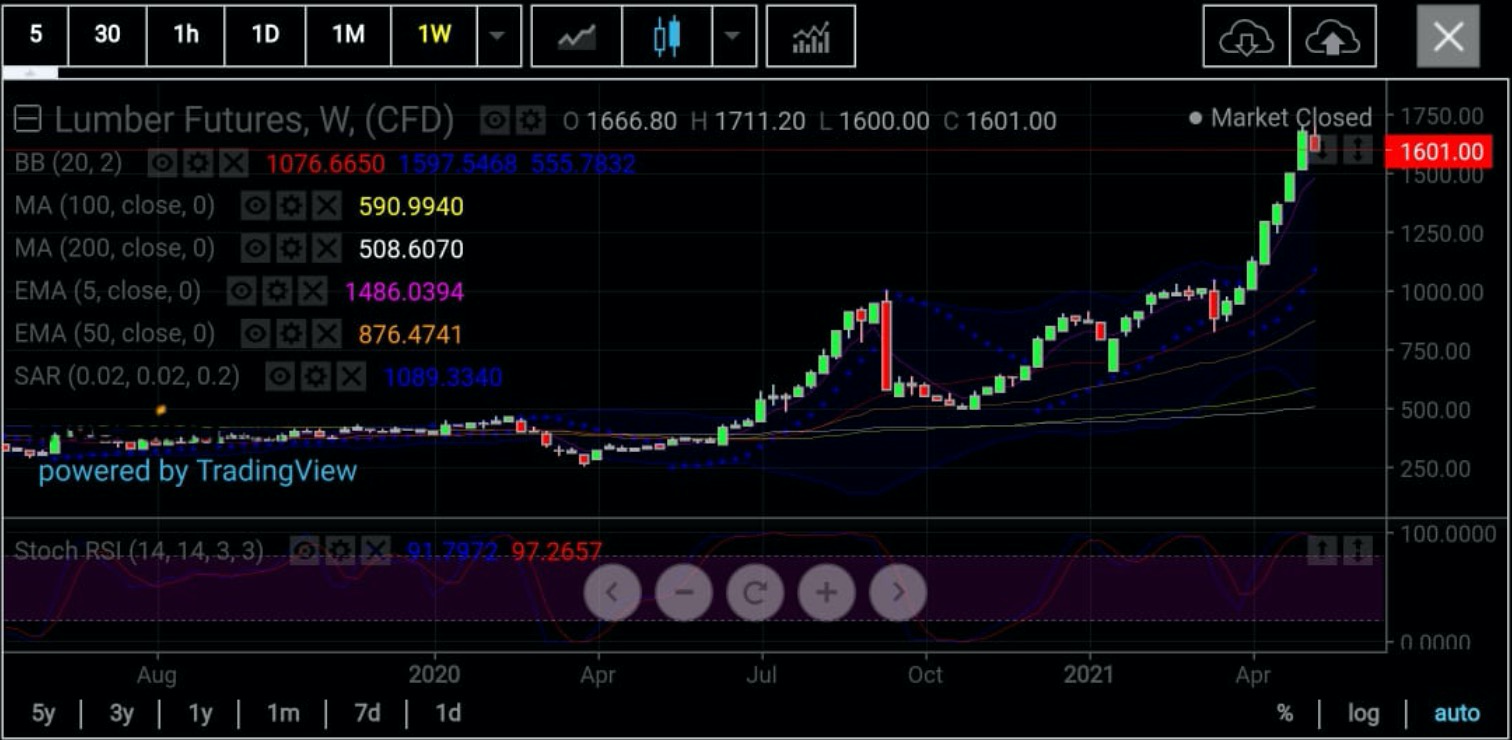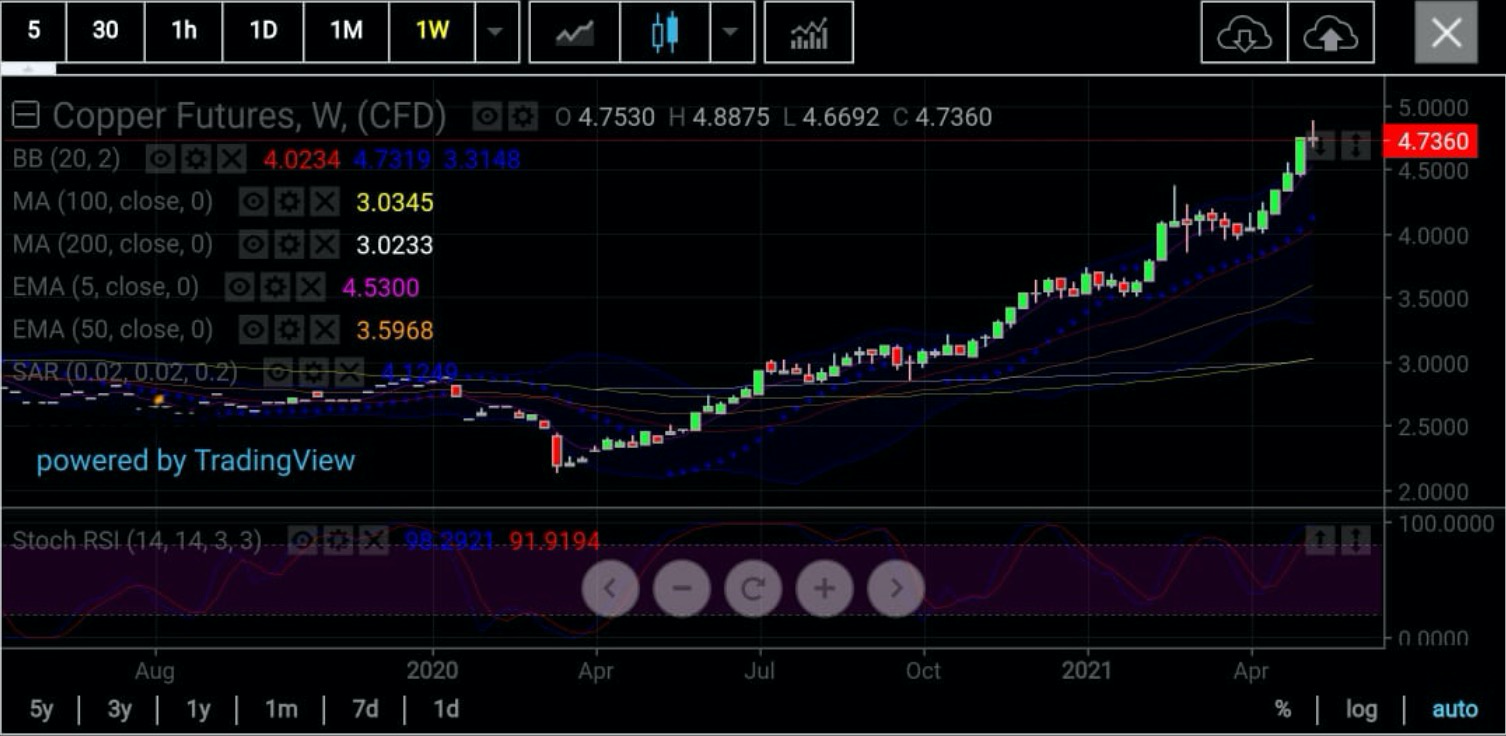First it was lumber. Then copper. Now, it’s iron ore.
Price pressures in building materials are just skyrocketing in the United States as an economy rip-roaring in its recovery from COVID-19 sets up an inflationary environment possibly not even seen after the Great Recession of the last decade.
The US economy expanded at an annual rate of 6.4% in the first quarter of this year, after the pandemic-induced contraction of 3.5% for 2020. The Federal Reserve projects that growth through 2021 will be 6.5%.
The trouble is inflation. No one really knows what it’s going to be.
Officially, the Fed’s Federal Open Market Committee (FOMC), has forecast that the Personal Consumption Expenditures rate, a measure of inflation, will average 2.4% in 2021 and 2.1% in 2023.
Privately, most monetary policymakers at the Fed, led by Chairman Jerome Powell, are convinced that 2021 will not have the distinction of being a 2% inflation year.
Since the Fed announced its 2% target in 2012 for price pressures, the central bank has never achieved the goal for a calendar year. In fact, prior to the 2008/09 financial crisis, there were only four years when US inflation exceeded this target, from 2004 through 2007.
Powell particularly likes to think that the current inflationary pressures are fleeting, or, to use his favorite word, “transient.” The Fed chair believes that until 2023, there will not be any lasting inflation that will allow the metric to reach 2% for a calendar year. A good number of district Fed chiefs, who sit with Powell on the FOMC to decide on monthly interest rates, agree with their chairman.
The problem is with economists outside the central bank, specifically those who have the ears of Wall Street traders.
This constituency is almost certain that US inflation will be beyond anything projected as the economy makes what will be closest to a full recovery from the pandemic.
But even this group doesn’t believe it will average 2% this year. They are, however, convinced that price pressures will force the Fed to increase interest rates—which have been near zero since the COVID outbreak in March 2020—earlier than it expects and taper the accomodative monetary policy that has juiced stock markets almost throughout the pandemic.
Given their bets on price pressures, and the beauty of self-fulfilling prophecies—i.e. in order for inflation, the record highs in commodities must continue—let’s examine the three aforementioned building materials and see how much higher they can go, at least from a technical viewpoint.
Lumber: $2,000 Record High Projection
Lumber is wood turned into beams and planks and an essential raw material in home building.
A US lumber shortage has caused prices to more than triple within the last year and added thousands of dollars to the overall cost of new home construction in the country.
In just one year, the price of lumber has increased about 370%—reaching a record high above $1,700 per 1,000 bd ft. For context, lumber has historically fluctuated between $200 to $400.
Across the United States, the average price for a single home shot up by $35,872, according to an analysis conducted last week by the National Association of Home Builders.
In a recent survey in Nevada published by the Las Vegas Review-Journal, new, single-family homes, on average, can cost $25,000 more, and for larger homes, the lumber shortage could cost upward of $50,000 to $60,000 more.
Nat Hodgson, CEO of the Southern (NYSE:SO) Nevada Home Builders Association, was quoted saying about the survey:
“It’s an increase of that much of the same wood that you used 12 months ago for the house next door.”
Pricier wood impacted the cost of cabinets, doors and flooring he said.
“I’ve been in this industry since ’93, right here in this town, and this talk about lumber—I have never seen something so large increase so much,” Hodgson said. “I’d love to tell you it’s going to be over in a week or two, but it’s not unfortunately. It’s pricing the heck out of people to not be able to afford to buy a house.”
Lumber costs started creeping up last year, though in recent months, they have reached a crescendo.
The price per thousand board feet of lumber normally costs between $200 and $350.
According to the latest analysis by Random Lengths, the industry’s tracking firm, the prices as of the week ending Apr. 23, show the cost of framing lumber near $1,200 per thousand board feet—up nearly 250% since April 2020.
About five weeks ago, prices for lumber dropped about 15% but quickly jumped back later, said Hodgson. Lumber is typically used in framing a new home.
“It’s up to $1,300 as of today,” said Hodgson. “That’s insane. In history, it’s never been like that. If it was a small line item in a house, it would be OK if it’s going to increase your house cost by 1%. But no, lumber is one of the largest line items in the house budget.”
Most of this cost can be passed down to the consumer, but extremely tight supplies mean homebuilders are unable to start more projects.
Analysts are now warning that lumber prices could reach a flashpoint, where affordability becomes so limited that demand suddenly falls off. This has led the National Association of Home Builders to ask the Biden administration for a temporary pause on Canadian lumber tariffs, which currently sit at 9%.
US tariffs on Canadian lumber were first introduced in 1982, and represent one of the longest lasting trade wars between the two nations. The US is currently appealing a World Trade Organization (WTO) ruling that states its 2017 tariff hike was a breach of global trading rules.
As of Friday, July lumber futures listed on the Chicago Mercantile Exchange reached an all-time high of $1,711.20 per thousand board feet.

All charts courtesy S.K. Dixit Charting
While it’s hard to say how high it could fundamentally be driven by just demand, CME lumber technically could reach a new record high of $2,000 per thousand board feet at its current momentum, S.K. Dixit Charting of Kolkata, India, said in a technical analysis conducted for Investing.com.
Sunil Kumar Dixit, the company’s chief chartist said:
“Lumber prices gained traction post long time consolidation between the $500 - $1,000 range which resulted in a fiercely-blasting rally to the record highs of $1,711.”
“Prices are taking a breather with maiden support at the 5-week Exponential Moving Average of $1,486. A sustained move above the level can reignite the rally to the next level of $2,000.”
Copper May Find Real Resistance At Below $5/Lb
July copper hit record highs of almost $4.89 per lb on New York’s futures trade on COMEX on Monday while three-month copper futures on the LME, or London Metal Exchange, surged to an all-time peak of $10,746 a tonne.
Both are up about 35% on the year.
That puts copper just behind top energy commodity gasoline, which is up 44%, and corn (47%) and tin and soybeans (46% each).
Fundamentally, copper, like lumber, is also a solid choice for long investors in commodities as it is backed by two of the biggest growth stories emerging from the coronavirus pandemic: the Chinese and US economies.
As China rebuilds from the devastation of the pandemic, it is displaying almost a second version of its infrastructure roll-out in 2000 that made it the largest consumer of metals, particularly copper.
Even prior to COVID-19, the EU was on the path of a green revolution that would require enormous amounts of copper in the coming years for the electrification of most new vehicles sold in the bloc and the charging stations needed to power them. That’s not including the copper required for cabling and electricity conduction in other industries moving away from polluting fossil fuels.
On top of these, we now have the Biden administration’s aim of halving all American emissions by 2030.
The US proposals for greening include subsidies for private ownership of electric cars, adding 500,000 new charging stations across the country and converting 500,000 school buses and the entire government transportation fleet to zero-emission vehicles.
Those stations and that number of battery electric buses would alone require nearly 200,000 tonnes of copper, according to an estimate by investment bank Jefferies. Renewable energy typically requires an estimated five times more copper than conventional sources.
The combined China, EU and US demand for copper is probably what led Goldman Sachs to predict in mid-April that the red metal could go to $15,000 per ton on the LME by 2025, from its current rate of $9,000.
Copper will be crucial in achieving decarbonization and replacing oil with renewable energy sources, and right now, the market is facing a supply crunch that could boost the price by more than 60% in four years, Goldman said.
By the turn of decade, demand is likely to fly, surging as much as 900% between now and 2030 to reach 8.7 million tons if green technologies are adopted en masse, Goldman estimates. Even if this process is slower, demand will still surge to 5.4 million tons, or by almost 600%, says the bank, calling copper the “new oil.”

S.K. Dixit Charting says $5 per lb copper will be possible for New York-traded COMEX futures in the near term, albeit with some challenges.
“Copper with its unstoppable bullish streaks continues taking on one resistance after another,” said chief chartist Dixit.
“The up move above the previous resistance of $4.30 came rather quickly. The move below the 5-week Exponential Moving Average of $4.53 will push copper down to the 20-Week Simple Moving Average and also middle Bollinger Band of $4.02. The $5 and above level will clearly act as real and tough resistance.”
Iron Ore Could See $220 Record, But Tough China Moves Too
Iron ore futures are up more than 30% on the year, hitting record highs of $204.35 per 500 dry metric tonnes on the Chicago Mercantile Exchange on Friday, as demand for steel boomed, analysts said.
The iron ore sector “is very, very hot,” Vivek Dhar, commodities analyst at Commonwealth Bank of Australia, said in a Bloomberg TV interview. “Supply is still not able to meet that strong demand.”
Iron ore futures in Singapore jumped to over $226 a ton, a record. Contracts in Dalian rose by the daily limit.
The iron-ore boom comes as China’s steelmakers keep output rates above 1 billion tons a year, despite a swath of production curbs aimed at reducing carbon emissions and reining in supply.
It said those measures have boosted steel prices and profitability at mills, allowing them to better accommodate higher iron ore costs and potentially front-load output ahead of more environmental restrictions.
“There is a chance that ex-China demand can come back to such an extent that we still see steel demand pick up globally and that will see iron ore demand remain at these elevated levels,” Dhar of the Commonwealth Bank of Australia said.
Shipmakers and household goods manufacturers will eventually be unable to withstand elevated steel prices, the country’s state-run Xinhua News Agency reported on Sunday, citing analysis from the China Iron & Steel Association. The report said it would be difficult for steel to continue rallying.

S.K. Dixit Charting also foresees resistance for iron ore on COMEX, which it believes is poised for a $220 record next.
“There’s a lack of volume and liquidity for iron ore futures,” says chief chartist Dixit. “The run-away gap is most likely to bring the prices down to fill the gap at $180. But further upside possibilities exist for $220.”
Disclaimer: Barani Krishnan uses a range of views outside his own to bring diversity to his analysis of any market. For neutrality, he sometimes presents contrarian views and market variables. He does not hold a position in the commodities and securities he writes about.
